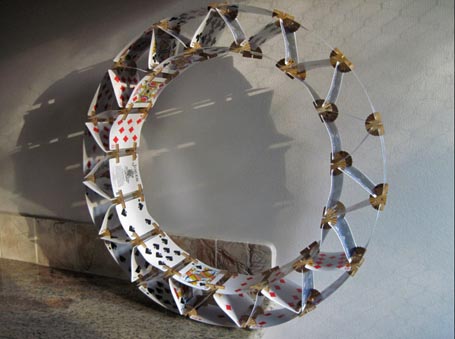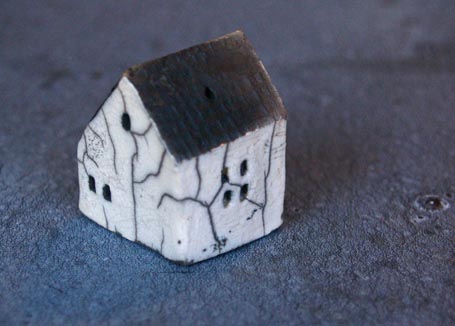
Entries from January 1, 2012 - January 31, 2012
Web tour: Skallops (a fun building toy) on Kickstarter
 photo courtesy of the Skallops Kickstarter pageWithin many a house enthusiast is an inner architect, designer, builder in search of an outlet. Search no more. Skallops, a fun buidling toy, awaits your discovery on Kickstarter. Skallops are the ingenious creation of the earnest folks at E&M Labs, LLC. Each Skallop is a little laser-cut, birch-plywood, scallop-shaped clip. Attach playing cards and/or other Skallops to build whatever you imagine.
photo courtesy of the Skallops Kickstarter pageWithin many a house enthusiast is an inner architect, designer, builder in search of an outlet. Search no more. Skallops, a fun buidling toy, awaits your discovery on Kickstarter. Skallops are the ingenious creation of the earnest folks at E&M Labs, LLC. Each Skallop is a little laser-cut, birch-plywood, scallop-shaped clip. Attach playing cards and/or other Skallops to build whatever you imagine.
Skallops will be funded via Kickstarter on February 1, but it isn't too late for you to kick in, and get a Skallop play pack of your own. Get a Starter Pack of 104 Skallops and two decks of playing cards. Or, get the Builder Pack, which includes twice the contents of the Starter Pack. Or, splurge on the Architect Pack, which includes twice the contents of the Builder Pack.
The folks who created Skallops note that, alternatively, you can clip together business cards or cards of your own creation. I'd love to see some Skallop houses. If you create a Skallop cottage or manse, let me know about it at the KHS Facebook Page. Meanwhile, happy building.
by Katie Hutchison for House Enthusiast
Design snapshot: Positive space
 Somewhere I have a winter picture of this little house with its assorted outbuildings, but this summer shot is a warm reminder on a cold day.
Somewhere I have a winter picture of this little house with its assorted outbuildings, but this summer shot is a warm reminder on a cold day.
The tiny outbuilding to the right looks to be about five feet from the back corner of the petite main house, which appears to border a courtyard of sorts, edged by yet another modest outbuilding. Together, these diminutive structures shape a mini compound. Their arrangement carves out several engaging outdoor rooms within the lot.
Some might refer to such outdoor rooms as negative spaces between structures. To me, they’re positive spaces -- the reward of mindful siting.
Check out another “Design snapshot” about cottage placemaking here.
by Katie Hutchison for House Enthusiast
Web tour: Scientific American: “Doorway effect” on memory
 At first, I was skeptical of the provocatively titled recent article “Why Walking through a Doorway Makes You Forget” in Scientific American Mind Matters. Then I remembered that only a few days before, I’d gotten up from my desk in my home office to retrieve a pen on my bedside table, and upon entering the bedroom and approaching the table, I had completely forgotten why I had gone in there. Apparently, I was experiencing the “doorway effect”.
At first, I was skeptical of the provocatively titled recent article “Why Walking through a Doorway Makes You Forget” in Scientific American Mind Matters. Then I remembered that only a few days before, I’d gotten up from my desk in my home office to retrieve a pen on my bedside table, and upon entering the bedroom and approaching the table, I had completely forgotten why I had gone in there. Apparently, I was experiencing the “doorway effect”.
According to the article by Charles B. Brenner and Jeffrey M. Zacks, a team of researchers at the University of Notre Dame has been investigating these types of minor memory lapses. They ran a series of experiments which determined that a shift in location, which involves passing into another room through a door and doorway, causes our memory to discard recently experienced memory from the previous room in order to make room in memory for new experiences in the next room. Interestingly, our memory doesn’t seem to discard recent memory when we move an equal distance elsewhere in the same room. It’s the transition through doors and doorways into different rooms that causes the effect. Plus, it doesn’t seem to help if a shift is back into the room where the memory was encoded; we still experience a memory lapse.
It’s fun to ponder the design implications of this kind of scientific finding. Perhaps it’s a good justification for keeping a home office distinctly separate from a home’s other living spaces, lest work pre-occupations seep into family time. Or perhaps it supports more open spaces in a senior living space, such that activities undertaken in a kitchen at one end of a space aren’t forgotten in a dining area at the other end of a space.
I’d be curious to know if the experiment holds true when the doorway doesn’t include a door. What if the doorway is oversized and doorless? Might transitions through column-supported soffits have a similar effect? The scientists note that in one of the virtual space experiments, the difference between the various rooms was reinforced by different wall patterns. What, then, if subjects were to travel between real spaces exhibiting markedly different finish treatments in which a nuanced transition is indicated by an opening in low walls with nothing overhead? Would there be a “doorway effect” beyond the transition? I’d love to know. Here’s hoping there’s more research conducted into the implications of architectural space on our thinking and behavior.
by Katie Hutchison for House Enthusiast
The simple saltbox
 For Christmas I received this delightful, little, ceramic house ornament from a friend. You can’t tell from the photo above, but it’s only 1 1/8” wide x 1 ¼” deep x 1 ½” tall. It has a matte-black, textured roof; shiny-white, glazed walls, accented by grey crackles resulting from raku firing; and recessed rectangular windows – some grey, some white. It’s easy to rotate and work in the palm of your hand in the manner of worry beads. It’s a charming charm.
For Christmas I received this delightful, little, ceramic house ornament from a friend. You can’t tell from the photo above, but it’s only 1 1/8” wide x 1 ¼” deep x 1 ½” tall. It has a matte-black, textured roof; shiny-white, glazed walls, accented by grey crackles resulting from raku firing; and recessed rectangular windows – some grey, some white. It’s easy to rotate and work in the palm of your hand in the manner of worry beads. It’s a charming charm.
It also satisfies my Recipe for Architectural Charm. Well, mostly. Since it isn’t sited, it cannot exhibit an engaged relationship with landscape. It, however, possesses all of the other required ingredients: grounding rooflines, legible massing, simple color palette and harmonious materiality, and thoughtful details.
It’s a saltbox, pure and simple -- a form to which I and so many others intuitively respond. I wonder what parts of our brains or chemistry are triggered by the saltbox form? What else similarly triggers them? Maybe if we knew, we could more readily create other forms or spaces that likewise appeal.
I’ve written about the influence of architecture/environment/space on us, our bodies and minds, before here and here. If you’re interested in acquiring the little, ceramic house for yourself or a friend, find it on etsy. If you have a hankering to see a saltbox-inspired addition I designed, check-out the Reading, Mass. Kitchen & Bath Renovation/Addition.
by Katie Hutchison for House Enthusiast















